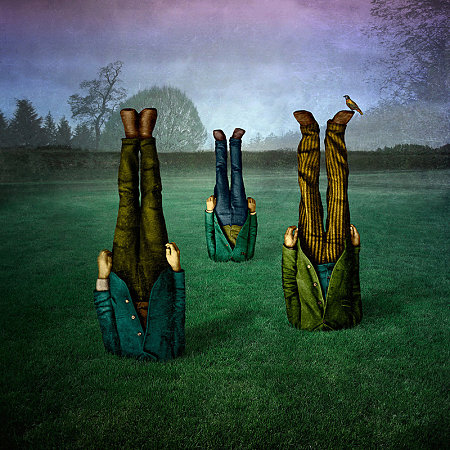
Global Positions
The digital field has darkened, and I haven’t even noticed. No gradation into night, no diminishing of the day, but our GPS assures us that darkness is inevitable. Black and white. I look outside. I unclip my sunglasses. Among the gentle hills and stretches of pines, light suddenly rises from the dark, as does civilization. Bright billboards spring up with more frequency: “Turn Here,” “Don’t Miss It,” “Entrance Ahead.”
In the distance, an odd structure rises—a blending of designs part alien spaceship and part Seattle space needle, lights surrounding the rim of a decidedly faux-Mexican motif. Beyond the Mexican space needle, more unidentifiable structures are scattered, many displaying the trademark sombrero.
“Should we stop?” I ask, second-guessing our original plan and knowing well my wife’s love/hate relationship with kitsch. As a collector, she responds to mid-century modern design; as an artist, she understands the limits of nostalgia. There’s a difference, she explains to me, between folk art, and even pop art that lasts beyond an era, and the bric-a-brac designed to evoke nothing more than mawkish romanticism. I understand what she means.
In Virginia is Busch Gardens: “Old Country.” I’ve been there, followed the map south toward U.S. 13, drove the span across the Chesapeake, and experienced the theme park’s quintessential kitsch—Westworld without the peril, Europe without the jet lag, Elizabethan England, wandering minstrels, Globe Theatre reproductions, German beer gardens, knockwurst and sauerkraut, Parisian gift shops, fleur-de-lis embossed crystal.
Chris flips through papers for our hotel reservation and estimates the distance.
“Let’s just pull over,” she says, and I look for a wide enough section of shoulder along the interstate as my wife reaches to the back seat for her camera.
She stands on the edge of the highway and shoots. The car rocks in the wake of passing trucks and tour buses, and I can barely make out her form against the blackness of night. Our hazard lights flash into the darkness. Above my wife drifts a summer constellation: Lyra or the Northern Cross. In the distance, bright lights are indicative of more earthly delights: eateries, trinket shops, arcades, and motor inns—all with the same Mexican flavor as the alien space needle rising skyward and blotting out the light from the stars above it. I want to believe in the miraculous. I want to believe in opening up to diversity and the eradication of borders and divisions. And in some ways, South of the Border is reminiscent of my father’s Mexico: the Tijuana, the Ensenada we visited in my infancy, depicted in his photos and stories—a destination for day trippers and night owls, a caricature of a country that had been transformed into American mythology in the service of quick commerce.
There is nothing miraculous about South of the Border. As my wife photographs the architecture, I imagine Pedro’s chili dogs, Pedro’s cheeseburgers, Pedro’s Philadelphia soft pretzels; his Amish quilts, his western boots, his silk screened t-shirts; his Guinea pigs and parakeets and goldfish—two to a bag—all laid out beneath the darkness of the South Carolina countryside. My father would have gladly explored this place from one end to the other as if he were back on the streets of Tijuana, even as he would have been aware of Pedro’s absurdity, hip to Pedro’s desire to separate him from his money. But I am more naïve than I thought. Still, I eventually become disenchanted by what, at first, I was certain would be a miracle.
After returning to the car, Chris snaps her lens cover onto her camera as I pull onto the interstate. The bright lights of South Carolina’s Mexico fade into the distance as we plunge once more into the darkness of the countryside.
“Drive 42 miles,” our GPS commands.
*
In 2007, Chris and I set out on a road trip through the southwest—Texas, Arizona, New Mexico. Whether due to a lack of technological know-how or a lack of trust, we relied on our GPS sparingly and mostly used our map. Once past San Antonio, we gradually became familiar with the miles of dusty earth and scrub brush that shape the landscape of west Texas. The mammoth truck stop at Fort Stockton was a welcome relief in that sparse and predictable environment. We didn’t need a GPS to recognize our crossing into Arizona and the storied stands of saguaro and barrel cactus. Later, the high desert region of New Mexico and the foothills of Sangre de Cristo led us into Santa Fe and, eventually, back east toward Amarillo.
